Push notification
After selecting New Campaign, entering the Campaign Name, and selecting Push from the campaign options, you will be redirected to the Push campaign creation section.

- Detail
- Message
- Recipients
- Summary
Completed steps will be identified with a check mark.
For a detailed explanation of Push notifications status, please refer to the Push Notifications Status sections. The first section provides a sequence of common status values encountered during push notification processing, while the second section details the potential final status that indicates the push notification’s outcome.
CONFIGURING PUSH NOTIFICATIONSGo to the Preferences section to configure Push notifications.
Detail
In the Detail step,
- Select the App to be used to deliver the Push notification from the App Name dropdown. If your app has still not been integrated into the platform, you can check the Mobile App is currently in the Development environment option to get a feel of how the setup of a Push campaign is done.
-
Select Push as the type of campaign you are configuring.
-
Select Next.
Message
In the ‘Message’ step, the content to be delivered in the Push messaging campaign is put together. Push notifications are processed by the device’s operating system, which gives notifications a consistent look.
Five types of Push notifications are supported by the Communications Platform:

-
Regular Push: These are simple notifications that only include a message title and text. These notifications do not modify the Mobile App as they are only informative. If modifications or specific actions are required within the App, you must use one of the other types of Push Notifications. The behavior of Regular Push notifications is included in InApp, Geo Push, and Deeplink notifications.
-
InApp Push: These are regular push notifications with additional data displayed when the application is opened. These notifications consist of a Regular Push notification and additional data that is delivered to the application, which is displayed when it is opened. It is 100% the responsibility of the application’s developer to implement this content in the application’s code.
-
Silent Push: This type of push does not generate a visual alert when it reaches the device and requires additional processing by the application developer for its implementation.
-
Geo Push: This type of push notification is the foundation of location-based services. It is sent to all those subscribed app users near a set geographical location and radius around it, used to compare it to the current location of the Subscriber’s device. Only if it falls within the defined location will the Push Notification be delivered to the user's device. Geo Push notifications are unique events. They are only available when made, and they are not persistent.
-
Deeplink: This type of push notification uses a URL that goes to specific content or section within a Mobile Application. Specific content could be a view, a particular section of a page, or a specific tab. For iOS operating systems, the developer must implement the navigation to the view or section of his application. In the case of the Android operating system, the Operating System will take care of this type of navigation.
Regular push
This is the most basic push notification, and it is included as part of InApp, Geo Push, and Deeplink push notifications. The Platform supports delivering personalized Push Notifications for each subscriber. The notification is processed before it is sent, redirected to the device, and the message arrives personalized using a Subscriber Field.
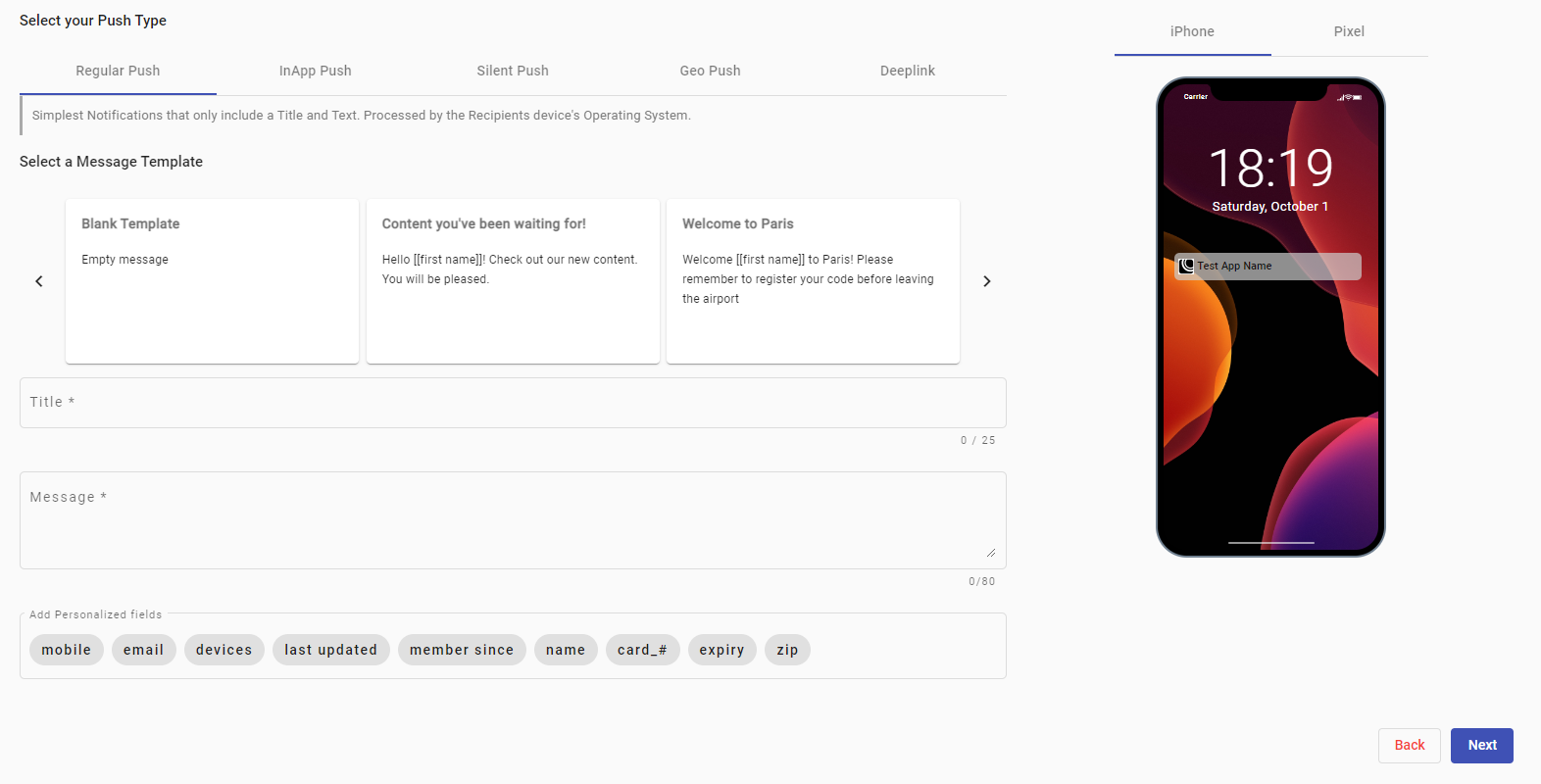
The steps to create a Regular Push Notification are the following:
- Select the Regular Push tab located at the top.

- Select an existing Push notification message template or start a message from scratch. The template includes the Push notification Title and message content, which can be modified to suit the campaign needs.

If you are starting from scratch, you need to:
a. Enter the Push Notification Title.
b. Enter the Message content in the textbox.
c. You can also add Personalized Fields into the message content. The options are the existing Subscriber List Fields and placeholders that are filled with each Recipient's information.
For example, if you wish to send a personalized Push notification to your Subscribers saying, _Hi_with the subscriber's Mobile Number, type in _Hi _and select 'mobile' from the Personalized Fields underneath the Message textbox.
NOTEAll Personalized Fields used are enclosed inside square brackets as follows [[personalized field]].
- You can preview the Push notification on the emulated phone screen on the right side for either iOS or Android.

The example that follows shows a notification sent to app users of a discount offering for a certain product or service.
NOTEThe icon and name that appear on the notification, depend on the App implementation that receives it.
InApp Push
InApp Push are regular Push notifications with additional data displayed when or if the application is opened.
The steps to create an InApp Push notification are the following:
- Select the InApp Push tab option located at the top.

-
Follow the details of step 2 described for a Regular Push to define the message as it follows the same configuration steps.
-
Enter the additional data to be sent to your application in the push payload. This is what differentiates an InApp notification from a Regular Push.
Key/values can deliver additional data you can use for a more complex, rich InApp push experience. For example:
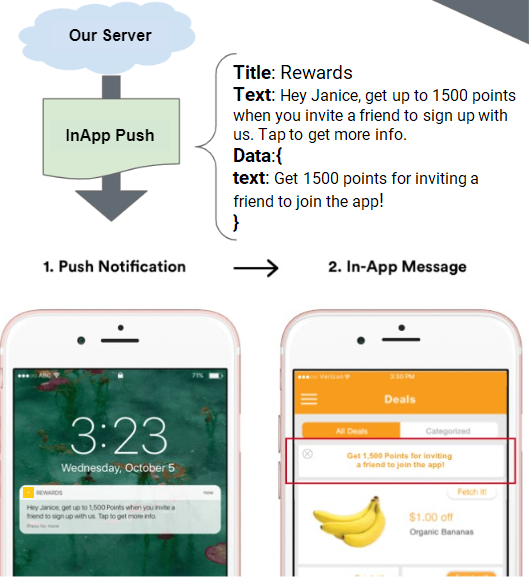
Platform - Choose the operating system of the mobile phone where you want to send the push notification: Android, iOS, or both.
Key / Value - is a set of two linked data items: a ‘key’, which is a unique identifier for some item of data, and the ‘value’, which is either the data identified or a pointer to the location of that data.
Once you have entered the additional data, click Add.
Silent Push
This type of Push does not generate a visual alert when it reaches the device and requires additional processing by the developer for its implementation.
The steps to create a Silent Push notification are the following:
- Select the Silent Push tab located at the top.

-
Enter the additional data to be sent to your application in the push payload:
Key/value pairs can deliver additional data you can use for a more complex, rich Silent push experience. For example:
The user wants to update the application's background color and background image.
Background ColorKey -> backgroundColor
Value -> green
Key -> Image
Value -> https://…
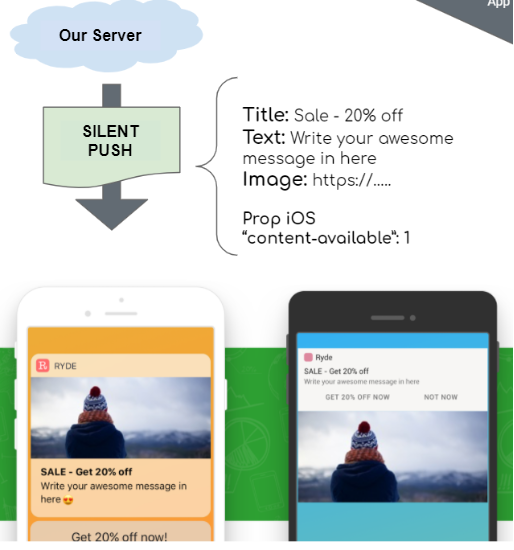
Platform - Choose the operating system of the mobile phone where you want to send the push notification: Android, iOS, or both.
Key / Value - is a set of two linked data items: a ‘key’, which is a unique identifier for some item of data, and the ‘value’, which is either the data that is identified or a pointer to the location of that data.
Once you have entered the additional data, click Add .
Geopush
For a Subscriber to receive a Geo Push Notification, the following are required:
- Has to have the App loaded on to the device
- App Permission to device location
- Internet connection
- To be SDK integrated
- Be within the perimeter of the defined location
NOTEGeo Push Notifications require modifications by the application developer for notification processing.
The steps to create a Geo Push notification are the following:
- Select the Geo Push tab located at the top.

-
Follow the details of step 2 described for a Regular Push to define the message as it follows the same configuration steps.
-
Add the location of interest by clicking Add location.
Once clicked, a dialog will appear to configure the desired Location and Radius. Enter the desired Address, then set the desired Delivery Radius. Once these two points are defined, click ‘Save’.
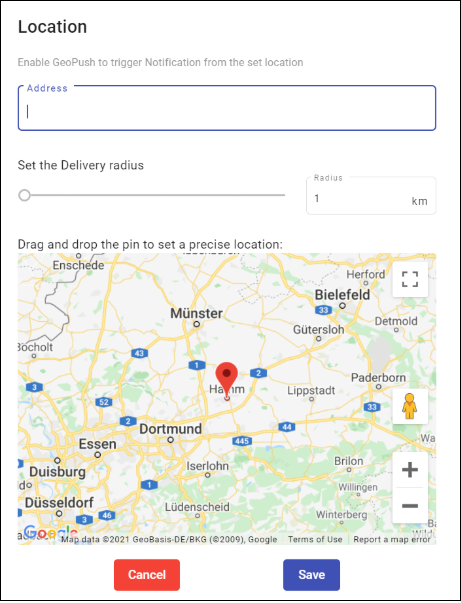
-
Enter the additional data to be sent to your application in the push payload:
Key/values can deliver additional data you can use for a more complex, rich Geo Push experience.
Geo Push guarantees that users will be notified if they are within the defined location.
For example, if your customers are close to any of your stores, they will be notified. As additional data, your customers are notified of the exact distance to the nearest store.
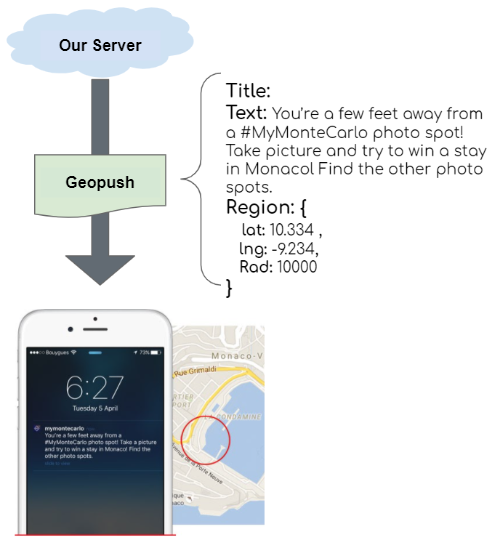
Platform - Choose the operating system of the mobile phone where you want to send the push notification: Android, iOS, or both.
Key / Value - is a set of two linked data items: a ‘key’, which is a unique identifier for some item of data, and the ‘value’, which is either the data that is identified or a pointer to the location of that data.
Once you have entered the additional data, click Add.
Deeplink
DeepLink notifications require modifications by the application developer for notification processing.
The steps to create a DeepLink Push Notification are the following:
- Select the Deeplink tab located at the top

-
Follow the details of step 2 described for a Regular Push to define the message as it follows the same configuration steps.
-
Target URL
Android allows you to displace the value (URL - web address) for deep-linking provided by the user. On the other hand, iOS requires additional data to specify the value (URL - web address) for deep-linking.
- Enter the additional data to be sent to your application in the push payload:
Key/values can deliver additional data you can use for a more complex, rich Deep Link push experience.
For example, Notifying their customers about a special offer on a specific item. The user must provide the location of the item using deep links.
Key -> URL
Value -> https://www…
Platform - Choose the operating system of the mobile phone where you want to send the push notification: Android, iOS, or both.
Key / Value - is a set of two linked data items: a ‘key’, which is a unique identifier for some item of data, and the ‘value’, which is either the data that is identified or a pointer to the location of that data.
Once you have entered the additional data, select Add.
After you have finished configuring the Push notification you selected, select Next to advance to the next step in the process.
Recipients
In this step, define the Recipients that will receive the Push campaign.
The steps to configure the Recipients are the following :
- For Push Notifications, the list of Subscribers that can receive the Push is registered by the SDK integration.
To configure the SDK integration, go to the SDK Documentation.
-
To segment the Delivery of the campaign to specific Subscribers, a Filter may be applied.
From the Filter dropdown, you can select any filter available in the dropdown, create a new filter, or select none:
-
None - It will offer the option to apply a Filter to the Delivery. By default, no filters will be applied, and the message will be delivered to all subscribers.
-
Create a New Filter - Create a new Filter to Segment Subscribers based on Rules. Use Filters to segment Subscribers based on set Rules placed on Subscriber List Fields.
If you want to create a new filter, a Dialog will open to start the Filter creation process.
For more information on creating a New Filter, go to the Filters section.
- The platform will automatically detect the number of Subscribers that have a valid registration with the SDK and can receive the campaign. It will define the following:
-
Number of Subscribers that have a valid registered Device
-
Number of Subscribers that don’t have a registered Device
In the following Subscriber List, for example, it has detected 2 Subscribers with Valid registered Devices and 2 Subscribers that do not have a registered Device.
To view more information on these detected Subscribers, click on any of the two boxes, and a Dialog will appear with the Subscriber Fields.
After selecting the Recipients, select Next.
Summary
In Summary, the final step of the Push campaign creator is where you can,
- Review Messaging campaign Details
- Select/unselect configured link tracking settings
- Set the delivery timetable
- Set the message delivery throughput and
- Set a Fallback Configuration for delivery
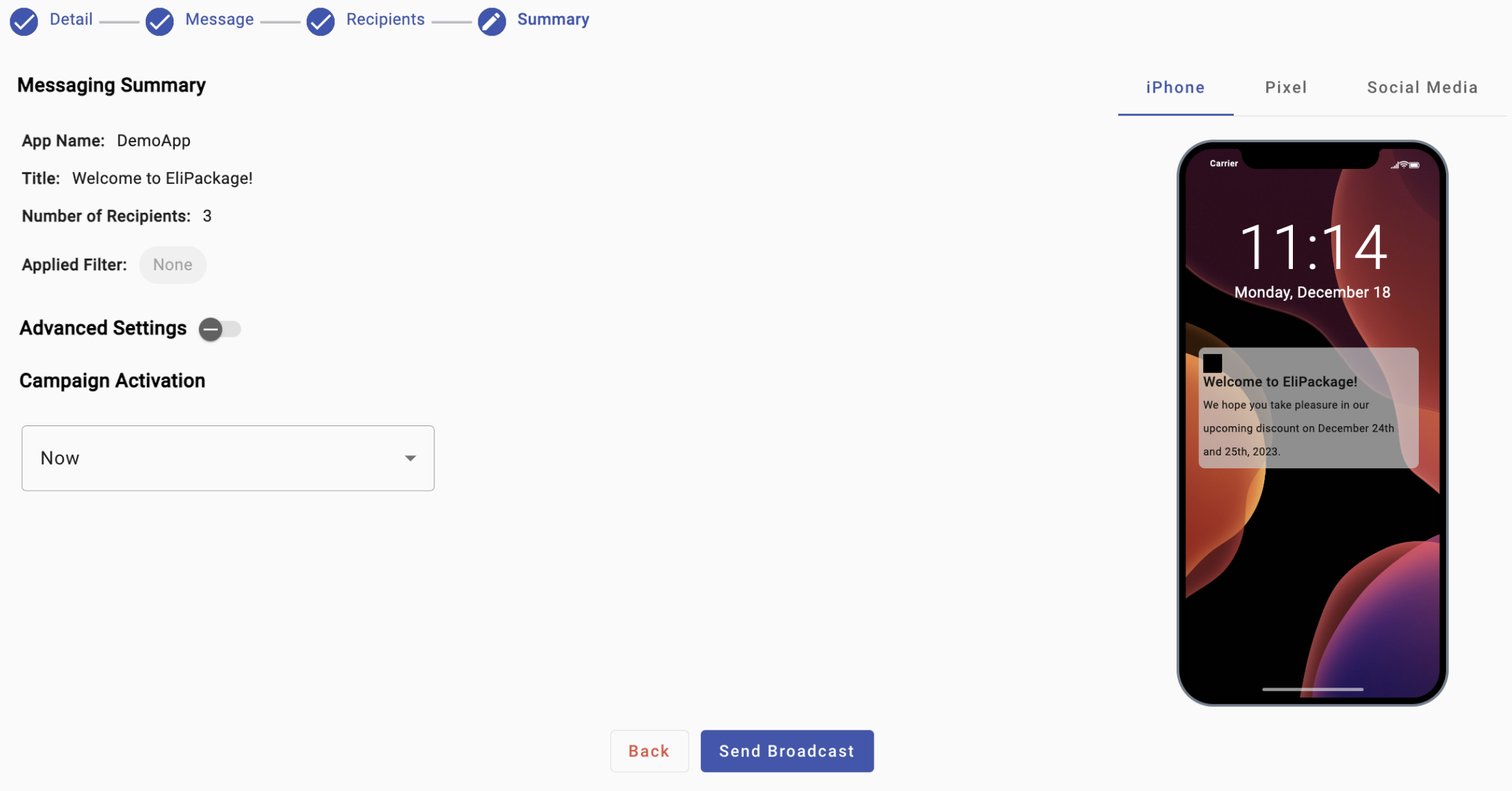
The Messaging Overview offers a quick way to double-check the Sender Number, the number of recipients, whether filters are applied, and the message contents in the emulated device screen.
For more information about the Summary step settings, go to Summary in the Campaign Elements section.
Edit Push Campaign
To be able to edit the Push campaign, the notification must not be sent yet. That is, once the user has completed each step and the campaign activation has been saved as "Draft" or "Schedule", you will be able to edit each step configuration of the campaign.
The steps to edit a Push campaign are the following:
- Click on the Reports icon and select the Messaging tab. Then, locate the campaign saved as Pending (Draft) or Schedule status and click on the Report button.
- From the campaign card, click on the Edit button. Once clicked, it will redirect you to the last step of the campaign configuration.
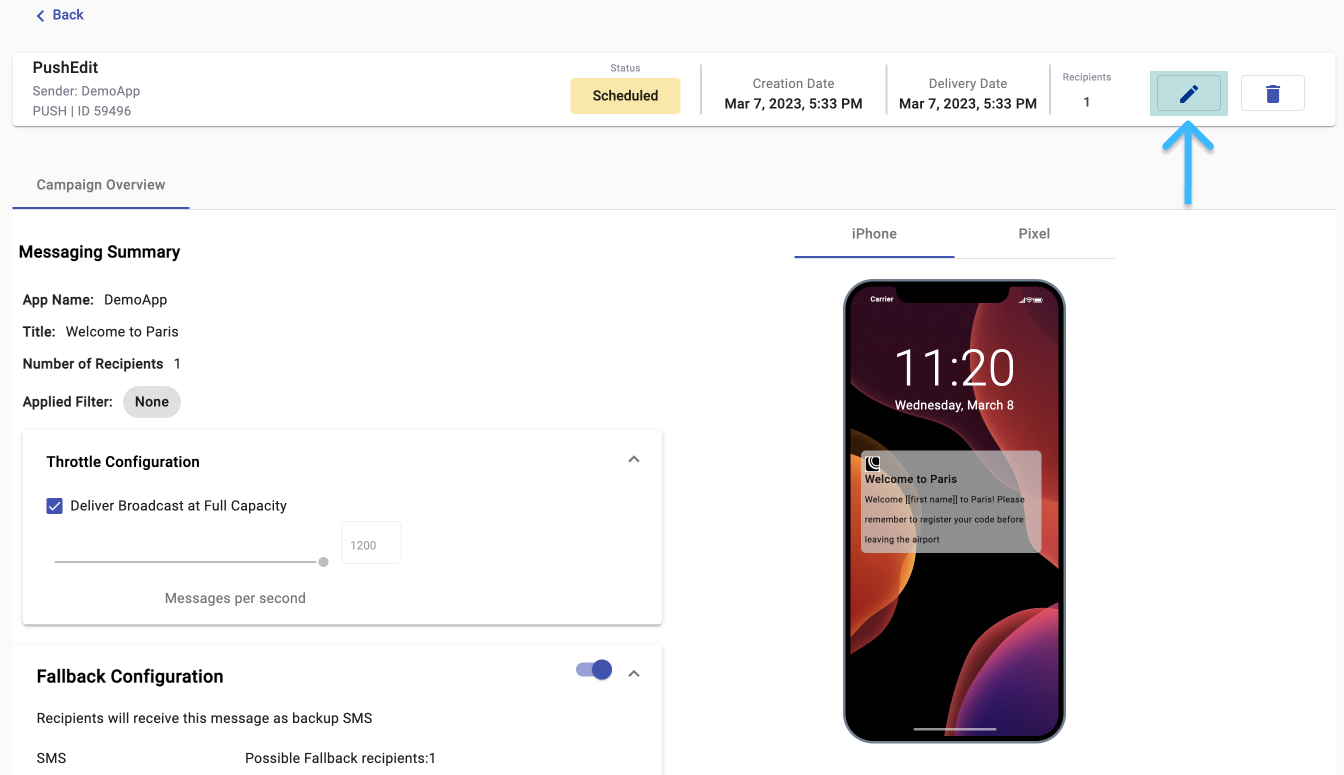
You can edit the:
- Push Messaging Details as selecting the checkbox if the mobile app is currently in Development environment.
- Push type notification, select another type of notification, or create a new one.
- Recipients who will receive the notification.
- Throttle configuration and Fallback configuration.
- Campaign activation.
Once finished with the edition, select the Campaign Activation button located in the Summary section.
Updated 2 days ago
